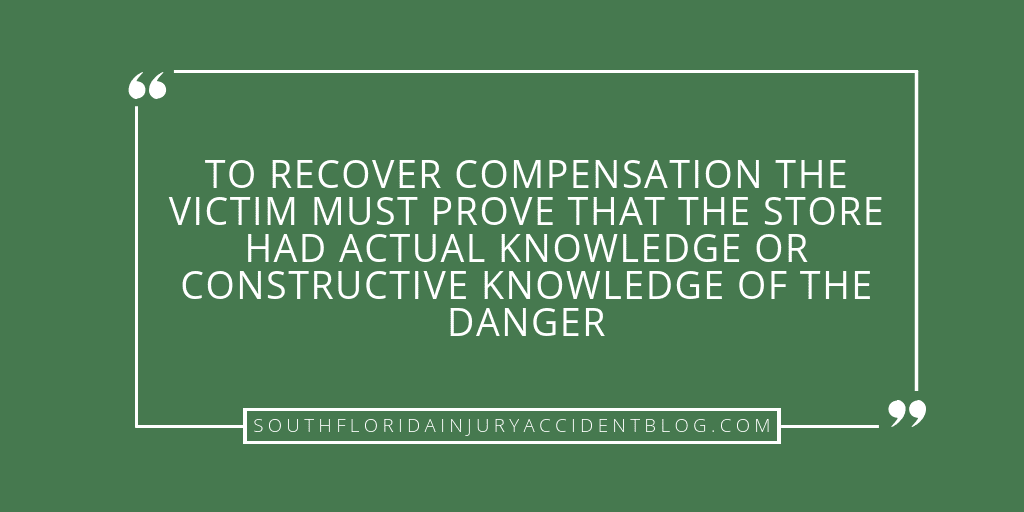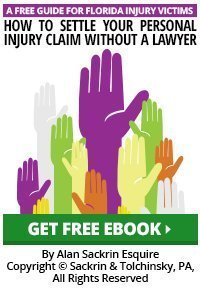Updated: 6/14/25
Grocery stores, superstores (Walmart, Target, Costco, etc.), and any business premises where food or other products may fall onto the floor require a more intensive floor inspection program than other business premises.
In this article, we’ll break down:
- What to do immediately when you have a grocery store slip and fall.
- What do you have to prove in order to receive a settlement from the grocery store?
- How do you prove the grocery is at fault for your slip and fall?
- How to add value to a grocery store slip and fall claim.
- What should you do now?
Quick Help: What to do immediately when you have a grocery store slip and fall:
- If you are able, try to take immediate notice of what caused you to fall.
- If possible, take pictures of where you fell and what caused you to fall. If not, have someone else take pictures of the scene.
- Gather the name and contact information of any witnesses (if any), including employees.
- Request that an incident report be prepared and that a copy be provided to you.
- Ask that any video surveillance be preserved.
- Take an ambulance to the hospital if your injuries are significant enough. Otherwise, seek medical treatment as soon as possible.
- Give an accurate history of what occurred to any healthcare provider you see.
- Provide an accurate account of any medical history to any health care provider, including whether or not you had previous problems in the area(s) of the body you injured in the fall
Going to the grocery store – it’s something we all do. Whether it’s taking the full grocery list to buy a week’s worth of food for family meals, or running into the local supermarket or corner store to grab diapers or beer or milk, shopping at the grocery store or supermarket chain is a common denominator for almost every adult.
Because we frequent these stores so often, most of us are aware, or at least we should be, of the risks we face when we go to a grocery store or supermarket — a slip and fall (aka a trip and fall) that can result in someone being hurt, sometimes seriously. Things like slippery floors, food debris and obstructed aisles can cause shoppers to lose their footing and fall down.
People get hurt all of the time in stores like Publix, Walmart, Costco, or Winn Dixie, by things like:
- Spilled shampoo or soap in the hair care aisle
- Water spray hits the floor making the floor slippery in the produce section
- Canned goods dropped in the aisle
- Broken bottles in the aisle (like pickles, mayonnaise, and peanut butter)
- Bags that have been opened with contents tossed into the aisle (cereal, cookies, chips, etc.)
- Nuts, seeds, or candies dropped out of display bins.
- Spilled milk (the white floor is wet or the floor is dry and sticky)
- Bananas, grapes, or other fruits or vegetables in the produce aisle
- Melted ice cream (the white floor is wet or the floor is dry and sticky)
- Display pieces that have fallen off of the display
- Deli counter tickets on the floor
In Florida, slip and fall accidents in grocery stores are covered by our “premises liability” law. This means, if an injured person can meet the proof requirements, then Florida law will hold the grocery store, supermarket or convenience store owner liable for the injured person’s damages, including:
- pain and suffering,
- medical expenses (past and future),
- lost wages, and
- other economic and non-economic items.
Common injuries from slip and falls include:
- Hand and wrist injuries,
- Foot fractures,
- Head injuries,
- Broken or bruised hips,
- Lacerations and cuts, and
- Ankle injuries.
Quick Tip: The Average Grocery Store Slip And Fall Settlement Is $35,000.00 (Details)
What Do You Have To Prove In Order To Receive A Settlement From The Grocery Store?
An injury victim will have to provide evidence that the grocery store was at fault because it had actual knowledge or constructive knowledge that there was a dangerous condition at the store which was the cause of the person’s injury. Florida Statute 768.0755 provides:
Premises liability for transitory foreign substances in a business establishment.—
(1) If a person slips and falls on a transitory foreign substance in a business establishment, the injured person must prove that the business establishment had actual or constructive knowledge of the dangerous condition and should have taken action to remedy it. Constructive knowledge may be proven by circumstantial evidence showing that:
(a) The dangerous condition existed for such a length of time that, in the exercise of ordinary care, the business establishment should have known of the condition; or
(b) The condition occurred with regularity and was therefore foreseeable.(2) This section does not affect any common-law duty of care owed by a person or entity in possession or control of a business premises.
What does this statute mean to someone who fell at a grocery store or superstore? In order to get a settlement and recover your damages, the victim must have evidence that the store was at fault because it had actual knowledge of a dangerous condition, or that the store had constructive knowledge – meaning, the danger was there long enough that someone exercising ordinary care would have known about the dangerous condition and had time to warn and address the condition.
See:

How Do You Prove The Grocery Store Is At Fault For Your Slip And Fall?
Grocery stores have a legal duty of care, including a duty to warn of dangerous conditions — by law, they are supposed to have people whose job involves inspecting the store’s floors and all the aisles routinely to make sure that they are safe, and to mop up any spills and move any obstacles in the store aisles. Employees should be going up and down the aisles of the grocery store on a routine, regular basis — say every 30 minutes or so — checking on things to make sure that store customers are safe from the risks of transitory substances on the floor, falling objects or other dangerous conditions. Stores should also take measures like:
- Train store employees to notify the store manager of any hazards immediately.
- Train store workers to keep aisles safe by quickly cleaning up spills or removing fallen items.
- Have employees tasked with things like making sure stocks and displays are set up in ways designed to prevent injury?
- Have as part of worker’s job duties to keep all store walkways including aisles, selling areas, check-outs, parking lots, etc., free from dangerous conditions.
It a victim can show an employee did not do their job, or didn’t do so in a timely manner, and show the store knew or should have known about the dangerous condition (this can be accomplished through discovery, including depositions and reviewing videotape footage of the accident scene), then the victim should be entitled to be compensated.
For instance, in the case of Grizzard v. Colonial Stores, Inc., someone went into the grocery store and slipped and fell on “… partially frozen, partially liquified orange juice concentrate.” The court held that the victim had to provide admissible evidence that the substance was on the grocery store’s floor “… for sufficient length of time to charge grocery store with constructive knowledge of its existence….“
The key here: The nature of the inspection and any warning of a dangerous condition that is required of store employees depends upon the use and nature of the property; grocery stores, including supermarkets and superstores, or any food selling location where food or other products may fall onto the floor require a more intensive floor inspection program than say a hospital that has no products or food nearby that might drop onto the floor. See Calvache v. Jackson Memorial Hosp., 588 So. 2d 28 (Fla. 3d DCA 1991).
How can you prove these elements of negligence? As mentioned above, the victim will have to find evidence through things like witness statements, surveillance video, and even the store’s own internal files and records.
It can be done. Consider the victory by the injured person in Winn-Dixie Stores, Inc. v. Guenther, where a man who was shopping for groceries with his wife and daughter fell and hurt his knee when he slipped on some clear liquid left on the floor of a grocery store aisle.
1. The victim provided evidence to the court that this clear liquid “… made a puddle about three feet long, appeared dirty and had scuff marks and several grocery cart marks running through it….”
2. He also provided evidence that the grocery store’s manager worked from an “...elevated platform within the store and by looking at spot where claimant fell, would have been able to see the liquid….”
Even though there was no evidence of how long that stuff was on the floor, the fact that the victim was able to show where the store manager was – and how big that puddle had been that caused him to fall, the court found for the injured man and the store had to pay for his accident damages.
How To Add Value To A Grocery Store Slip And Fall Claim
One way an experienced Florida personal injury lawyer can add value to a victim of a grocery store slip and fall is to share with the victim how insurance companies normally respond to these claims, along with assisting in getting the proof needed to prevail with a claim. Proof can include obtaining surveillance video and maintenance logs, especially when the store declines, which they always do. Depositions are equally as helpful especially when it involves questioning the people who are in charge of routinely checking for dangerous conditions.
What Should You Do Now?
The last thing anyone wants is to be re-victimized by a negligent party making a lowball offer. Accordingly, a good piece of advice, if you have been injured in a grocery store slip and fall, is to speak with an experienced lawyer before you file a claim to learn about some of the issues that can arise when seeking compensation, including the amount of damages you can recover and the amount of time it takes to get a settlement. Most personal injury lawyers, like Alan Sackrin, will offer a free initial consultation (over the phone or in-person) to answer your questions and explain your options.
NOW WATCH:
Related:
- What is the best accident claim advice that I can share?
- How do the clothes I am wearing affect a slip and fall?
_______________
 Do you have questions or comments? Then please feel free to send Alan an email or call him now at (954) 458-8655.
Do you have questions or comments? Then please feel free to send Alan an email or call him now at (954) 458-8655.
If you found this information helpful, please share this article and bookmark it for your future reference.

This is the perfect information to have when you think you may have a slip and fall claim. The sooner you can contact your attorney, the better it will be for you. Thanks so much for posting!